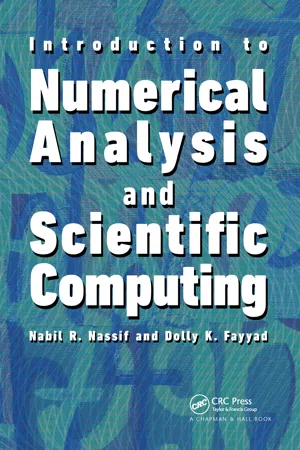
eBook - ePub
Introduction to Numerical Analysis and Scientific Computing
Nabil Nassif, Dolly Khuwayri Fayyad
This is a test
Condividi libro
- 329 pagine
- English
- ePUB (disponibile sull'app)
- Disponibile su iOS e Android
eBook - ePub
Introduction to Numerical Analysis and Scientific Computing
Nabil Nassif, Dolly Khuwayri Fayyad
Dettagli del libro
Anteprima del libro
Indice dei contenuti
Citazioni
Informazioni sul libro
Designed for a one-semester course, Introduction to Numerical Analysis and Scientific Computing presents fundamental concepts of numerical mathematics and explains how to implement and program numerical methods. The classroom-tested text helps students understand floating point number representations, particularly those pertaining to IEEE simple an
Domande frequenti
Come faccio ad annullare l'abbonamento?
È semplicissimo: basta accedere alla sezione Account nelle Impostazioni e cliccare su "Annulla abbonamento". Dopo la cancellazione, l'abbonamento rimarrà attivo per il periodo rimanente già pagato. Per maggiori informazioni, clicca qui
È possibile scaricare libri? Se sì, come?
Al momento è possibile scaricare tramite l'app tutti i nostri libri ePub mobile-friendly. Anche la maggior parte dei nostri PDF è scaricabile e stiamo lavorando per rendere disponibile quanto prima il download di tutti gli altri file. Per maggiori informazioni, clicca qui
Che differenza c'è tra i piani?
Entrambi i piani ti danno accesso illimitato alla libreria e a tutte le funzionalità di Perlego. Le uniche differenze sono il prezzo e il periodo di abbonamento: con il piano annuale risparmierai circa il 30% rispetto a 12 rate con quello mensile.
Cos'è Perlego?
Perlego è un servizio di abbonamento a testi accademici, che ti permette di accedere a un'intera libreria online a un prezzo inferiore rispetto a quello che pagheresti per acquistare un singolo libro al mese. Con oltre 1 milione di testi suddivisi in più di 1.000 categorie, troverai sicuramente ciò che fa per te! Per maggiori informazioni, clicca qui.
Perlego supporta la sintesi vocale?
Cerca l'icona Sintesi vocale nel prossimo libro che leggerai per verificare se è possibile riprodurre l'audio. Questo strumento permette di leggere il testo a voce alta, evidenziandolo man mano che la lettura procede. Puoi aumentare o diminuire la velocità della sintesi vocale, oppure sospendere la riproduzione. Per maggiori informazioni, clicca qui.
Introduction to Numerical Analysis and Scientific Computing è disponibile online in formato PDF/ePub?
Sì, puoi accedere a Introduction to Numerical Analysis and Scientific Computing di Nabil Nassif, Dolly Khuwayri Fayyad in formato PDF e/o ePub, così come ad altri libri molto apprezzati nelle sezioni relative a Matemáticas e Matemáticas general. Scopri oltre 1 milione di libri disponibili nel nostro catalogo.
Informazioni
Chapter 1
Computer Number Systems and Floating Point Arithmetic
1.1Introduction
1.2Conversion from Base 10 to Base 2
1.2.1Conversion of the Integral Part
1.2.2Conversion of the Fractional Part
1.3Conversion from Base 2 to Base 10
1.3.1Polynomial Evaluation
1.3.2Conversion of the Integral Part
1.3.3Conversion of the HYactional Part
1.4Normalized Floating Point Systems
1.4.1Introductory Concepts
1.4.2IEEE Floating Point Systems
1.4.3Denormalized Numbers in MATLAB
1.4.4Rounding Errors in Floating Point Representation
1.5Floating Point Operations
1.5.1Algebraic Properties in Floating Point Operations
1.5.2The Problem of Absorption
1.5.3The Problem of Cancellation or Loss of Precision
1.6Computing in a Floating Point System
1.6.1Cardinality and Distribution of Floating Point Systems
1.6.2A MATLAB Simulation of a Floating Point System
1.6.3Tips for Floating Point Computation
1.7Exercises
1.8Computer Projects
1.1 Introduction
The main objective of this chapter is to introduce the students to modes of storage of users’ numbers in a computer memory and as well providing the readers with basic concepts of computer arithmetic, referred to also as Floating Point Arithmetic. Although the principles covered are general and can apply to any finite precision arithmetic system, we apply those principles only to Single and Double Precision IEEE (Institute of Electrical and Electronics Engineers) systems. For additional detailed references, we refer to [8], [14], [19] and [23].
In this view, we start by describing computer number representation in the binary system that uses 2 as the base. Since the usual decimal system uses base 10, we discuss therefore methods of conversion from one base to another. The octal and hexadecimal systems (respectively, base 8 and base 16 systems) are also introduced as they are often needed as intermediate stages b...